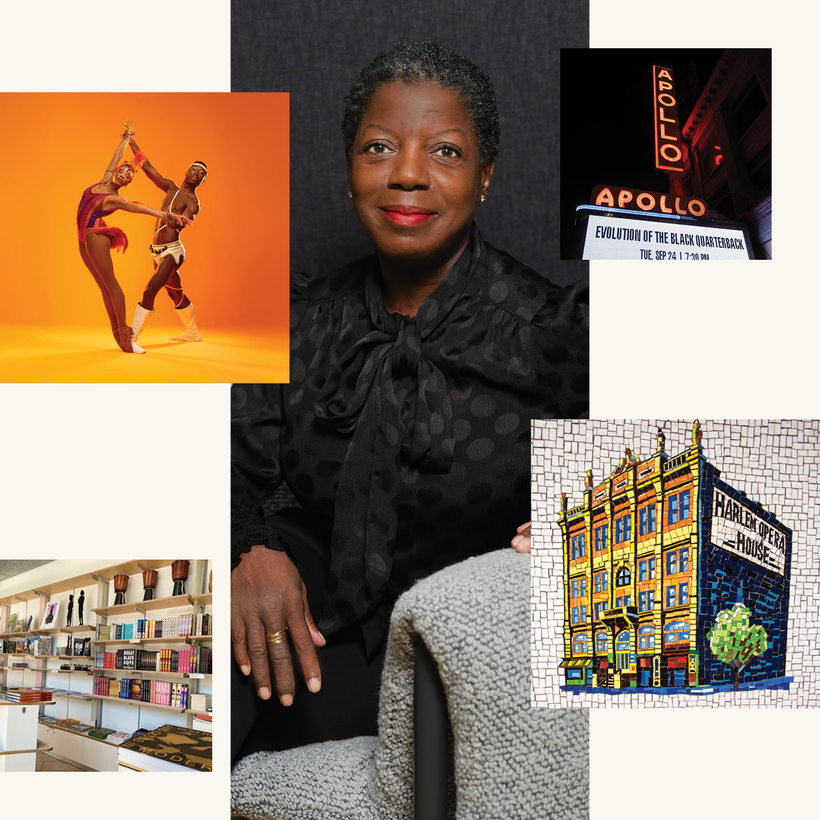If there is one person synonymous with the Harlem art scene, it’s Thelma Golden. She was born a few miles east, in Queens, where she first pored over H. W. Janson’s History of Art. Golden’s career started earlier than most: as a teenager enrolled at the New Lincoln School in Manhattan, she became a precocious curatorial apprentice at the Metropolitan Museum of Art. Later, in 1985, while completing her Bachelor of Arts at Smith College, she took a job at the Studio Museum, which she joined full-time after graduating in 1987.
A few positions took her away from Harlem—at the Whitney Museum of American Art, where she curated brilliant and sometimes controversial shows, and later working with the contemporary art collectors Eileen Harris Norton and Peter Norton—but in 2000 she returned as its deputy director for exhibitions and programs. Five years later, she became chief curator.
Just in time for the museum’s re-opening after renovations, Golden shares her guide to the neighborhood she calls home.

FLYING HOME: HARLEM HEROES AND HEROINES (DOWNTOWN AND UPTOWN), by FAITH RINGGOLD, at the 125TH STREET 2/3 SUBWAY STATION
While I live in Harlem, portions of my week are often spent elsewhere. One of my favorite ways of returning to this neighborhood is by taking the 2/3 line to 125th Street. On both the uptown and downtown sides of the 125th Street platform, commuters are greeted by an expansive mosaic mural by the Harlemite Faith Ringgold. Created in 1996, it depicts figures such as Josephine Baker, Zora Neale Hurston, Sugar Ray Robinson, and Malcolm X flying over local landmarks related to their legacies. This spectacular work immerses viewers in Harlem’s rich cultural legacy, setting the historical groundwork for everyone who steps into the station. (mta.info)

The Schomburg Shop
The Schomburg Center for Research in Black Culture, a branch of The New York Public Library, is an essential archive of Black culture and community. While I have had the privilege of attending so many events and exhibitions at this institution—especially as they celebrate their centennial this year—I can never resist stopping by the Schomburg Shop to browse, and often pick up, a selection of books by Black writers, thinkers, and poets. (schomburgshop.com)
National Black Theatre
The National Black Theatre’s history has always been entangled with that of the Studio Museum in Harlem. Both were founded in 1968 out of the very same cultural conditions, and both took a jewelry factory just above 125th street as their first home—the National Black Theatre was on the second floor, and the Studio Museum on the third. Today, the National Black Theatre is the longest-running theatre dedicated to showcasing and producing work by Black artists, from actors to playwrights and everyone in between. They are currently in the midst of an exceptional expansion project, which will give rise to a building that parallels the institution’s artistic ambition. (nationalblacktheatre.org)

Apollo TheateR
The Apollo Theater is a Harlem icon. Since opening its doors in the early 20th century and introducing the first Amateur Night contests in 1934, it’s hosted Ella Fitzgerald, Sarah Vaughan, Billie Holiday, Sammy Davis Jr., James Brown, Gladys Knight, Luther Vandross, D’Angelo, Lauryn Hill, and so many others who have come to define the music industry as we know it. While the Apollo is currently closed for renovations, its programs continue at The Apollo Stages at the Victoria Theater. (apollotheater.org)

Dance Theatre of Harlem
The Dance Theatre of Harlem has long been dedicated to uplifting expansive ideas around Black identity through the form of ballet. Founded by Karel Shook and Arthur Mitchell in a converted garage in Harlem in 1969, the company is said to have been created in the wake of Martin Luther King, Jr.’s assassination. Fifty-six years later, it remains an unparalleled space for genre-bending dance. What truly sets it apart, though, is its legacy of shaping multiple generations of talented performers. (dancetheatreofharlem.org)
Morningside Park
While New York has an abundance of beautiful parks, my favorite is Morningside Park. Stretching thirteen blocks—from 110th Street to 124th Street—Morningside features winding paths flanked by flora, a pond, waterfalls, and dramatic cliffs. Morningside has served as a home for the Studio Museum’s public art initiative, InHarlem, since we founded it in 2016 to bring Black art to the neighborhood’s public spaces. The park is also where I spend my Saturday mornings browsing, and often purchasing, fresh, local produce at its year-long farmers market. (nycgovparks.org)
You can explore our complete, constantly-updated guide to New York here
